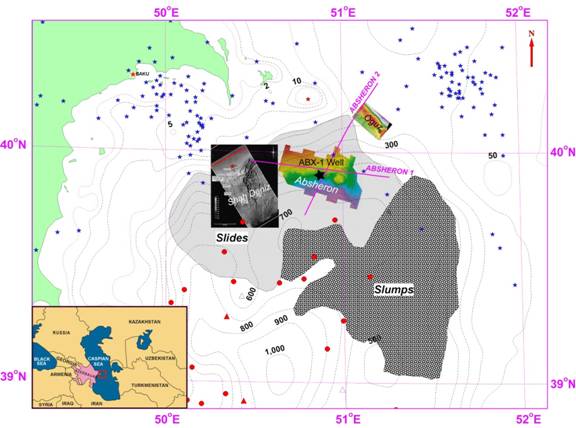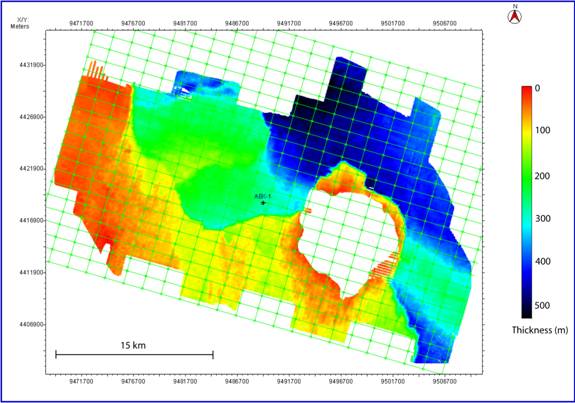www.acsprf.org
Reports: AC846170-AC8: Absheron Allochthon: Evidence for South Caspian Seafloor Deformation in Response to Climatically Driven Hydrate Dissociation
Camelia C. Knapp , University of South Carolina
Gas hydrates hydrates (also known as clathrates) consist of a gas molecule encased in a rigid lattice of hydrogen-bonded water molecules and have been studied from several different perspectives including climate change (Dickens et al., 1995, Kennett et al., 2000). The potential role of gas hydrates in climate change is explained by Kennett et al. (2003), who suggested that very rapid warming events during the Quaternary were due to the massive dissociation of marine gas hydrates rather than exhalation of methane from continental wetlands, and asset that many submarine slumps observed throughout the world's oceans are a product of sediment instability caused by the dissociation of gas hydrates. While this hypothesis is still heavily debated, several studies have linked large submarine slumping events to the dissociation of gas hydrates. This study attempted to add the Absheron Allochton (AA), a large late-Pleistocene submarine slump observed in the South Caspian Basin (SCB; Fig. 1) to the list of worldwide submarine slumps attributed to gas hydrate dissociation.
Quaternary submarine slumps have been studied worldwide due to their proposed relationship with the dissociation of gas hydrates and subsequent climate impacts. Massive dissociation of gas hydrates would likely occur when sea level is at a minimum, causing pressure on the hydrate reservoir within submarine sediments to also be at a minimum. The Khvalyn transgression in the Caspian Sea represents a ~100 m rise in sea level, which would create conditions favorable for the expansion of the gas hydrate reservoir by increasing the area which falls into the P/T conditions required for gas hydrates to form. The Yenotavian regression immediately following the Khvalyn transgression represents a ~100 m drop in sea level, which would potentially destabilize a large portion of the gas hydrate reservoir. Although the exact age is still debated, this major fluctuation in sea level is thought to have occurred at 70 - 15 ka (Kroonenberg et al, 1997; Mamedov, 1997). The calculated emplacement time for the AA of 35 - 42 ka falls within this age range for the Yenotavian regression, suggesting that the AA (Fig. 2) could have been caused by the dissociation of gas hydrates.
Other mechanisms for slumping in the SCB include high sedimentation rates and seismicity. However, no major slumping is observed below the Absheron series horizon which corresponds to 700 ka when sedimentation rates were reportedly higher, therefore high sedimentation is not likely the dominant slumping mechanism. Similarly, although the SCB is seismically active, no major slumping is observed throughout the seismic dataset prior to the AA. Given the occurrence of gas hydrates throughout the SCB and the correlation of the emplacement time of the AA with the reported timing of the Yenotavian regression, it is likely that the dominant slumping mechanism leading to the emplacement of the AA was the dissociation of marine gas hydrates. Furthermore, if the AA can be correlated to interpreted submarine slides and slumps reported by Abdullayev (2000), then the AA could represent a component of one of the largest submarine slump complexes worldwide.
Figure 1. Map showing the relative positions of the Absheron block, Shah Deniz block, and Oguz block, as well as the Absheron 1 and Absheron 2 2D seismic profiles. Preliminary ages were placed on the Absheron block by comparison to the Oguz and Shah Deniz structures (from Davies and Stewart, 2005, and Fowler et al., 2000, respectively). Note the area of interpreted submarine slides and slumps (from Abdullayev, 2000). Blue stars are earthquake epicenters from the ISC Catalog, red dots and triangles are mud volcanoes.
Figure 2. Isopach map of the AA.
References
Abdullayev, N. R. 2000. Seismic stratigraphy of the Upper Pliocene and Quaternary deposits in the South Caspian Basin. Journal of Petroleum Science and Engineering, 28: 207-226.
Dickens, G. R., J. R. O'Neil, D. K. Rea, R. M. Owen. 1995. Dissociation of oceanic methane hydrate as a cause of the carbon isotope excursion at the end of the Paleocene. Paleoceanography, 10 (6): 965-971.
Kennett, J. P., K. G. Cannariato, I. L. Hendy, R. J. Behl. 2000. Carbon isotopic evidence for methane hydrate instability during Quaternary interstadials. Science, 288: 128-133.
Kennett, J. P., K. G. Cannariato, I. L. Hendy, R. J. Behl. 2003. Methane Hydrates in Quaternary Climate Change, Washington D. C.: American Geophysical Union.
Kroonenberg, S. B., G. V. Rusakov, A. A. Svitoch. 1997. The wandering of the Volga delta: a response to rapid Caspian sea-level change. Sedimentary Geology, 107: 189-209.
Mamedov, A. V. 1997. The Late Pleistocene-Holocene history of the Caspian Sea. Quaternary International, 41: 161-166.


